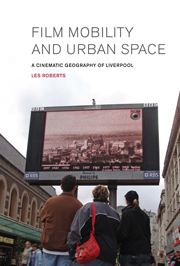Book contents
- Frontmatter
- Contents
- List of Illustrations
- Preface and Acknowledgements
- 1 Cinematic Geography: Mobilizing the Archive City
- 2 An Incriminated Medium? The City as Urban Spectacle
- 3 Cityscapes: Panoramas and the Mobile Gaze
- 4 City Limits: Crossing Boundaries of Place and Identity
- 5 Movie-mapping: Cinematographic Tourism and Place-marketing
- 6 World in One City: Travel, Globalization and Placeless Space
- 7 Cinematic Cartography: Mapping the Archive City
- Afterword
- References
- Index
Afterword
- Frontmatter
- Contents
- List of Illustrations
- Preface and Acknowledgements
- 1 Cinematic Geography: Mobilizing the Archive City
- 2 An Incriminated Medium? The City as Urban Spectacle
- 3 Cityscapes: Panoramas and the Mobile Gaze
- 4 City Limits: Crossing Boundaries of Place and Identity
- 5 Movie-mapping: Cinematographic Tourism and Place-marketing
- 6 World in One City: Travel, Globalization and Placeless Space
- 7 Cinematic Cartography: Mapping the Archive City
- Afterword
- References
- Index
Summary
In his review of the final Harry Potter film, Harry Potter and the Deathly Hallows: Part 2 (2011), The Guardian film critic Peter Bradshaw comments on the use of London's St Pancras railway station to represent nearby King's Cross, from where, in the stories, the Hogwarts train departs. Noting that ‘millions of tourists are undoubtedly convinced that this building is, in fact, King's Cross’, he concludes that ‘[St Pancras] may be forced simply to change its name’. Whether or not this actually happens, that such an outcome is even conceivable gives some insight into the ways film and cinematographic tourism practices can exert a powerful influence on not just how cities are imagined but also on the geographical reconfiguration of material urban landscapes. The more that the correspondence between on- and off-screen space is made explicit – that is, the more that location becomes a focus of attention, whether academically (in texts such as this) or as a site of discourse and practice more generally (film tourism guide books, movie maps and tours, virtual and interactive geographies of film in gallery and museum exhibits, online cine-maps, DVD compilations of archive footage of cities and other urban places, psychogeographies of film, site-specific film practices, screening of films in the locations where they were shot and so on) – the more the contradictory modalities of film and urban space are made manifest.
- Type
- Chapter
- Information
- Film, Mobility and Urban SpaceA Cinematic Geography of Liverpool, pp. 219 - 222Publisher: Liverpool University PressPrint publication year: 2012



